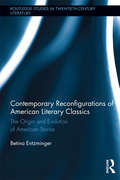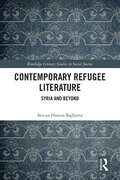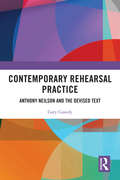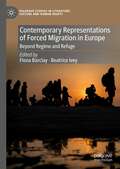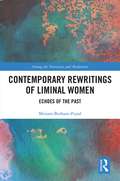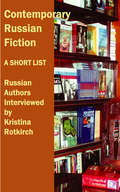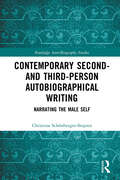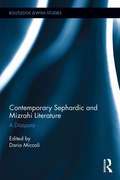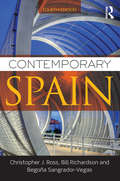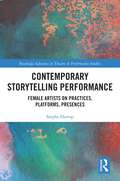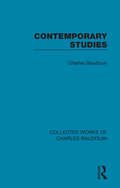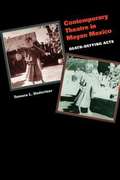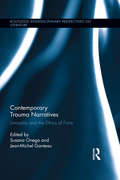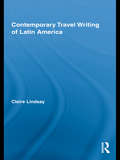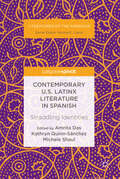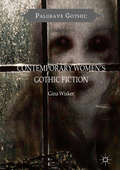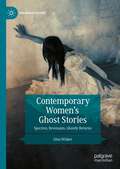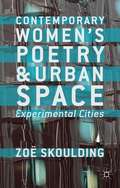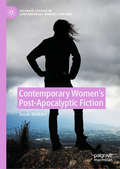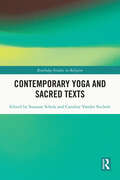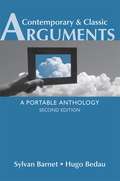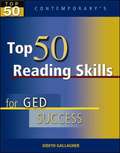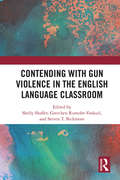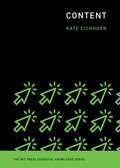- Table View
- List View
Contemporary Reconfigurations of American Literary Classics: The Origin and Evolution of American Stories (Routledge Studies in Twentieth-Century Literature #28)
by Betina EntzmingerThe number and popularity of novels that have overtly reconfigured aspects of classic American texts suggests a curious trend for both readers and writers, an impulse to retell and reread books that have come to define American culture. This book argues that by revising canonical American literature, contemporary American writers are (re)writing an American myth of origins, creating one that corresponds to the contemporary writer’s understanding of self and society. Informed by cognitive psychology, evolutionary literary criticism, and poststructuralism, Entzminger reads texts by canonical authors Poe, Hawthorne, Melville, Alcott, Twain, Chopin, and Faulkner, and by the contemporary writers that respond to them. In highlighting the construction and cognitive function of narrative in their own and in their antecedent texts, contemporary writers highlight the fact that such use of narrative is universal and essential to human beings. This book suggests that by revising the classic texts that compose our cultural narrative, contemporary writers mirror the way human individuals consistently revisit and refigure the past through language, via self-narration, in order to manage and understand experience.
Contemporary Refugee Literature: Syria and Beyond (Routledge Literary Studies in Social Justice)
by Sercan Hamza BağlamaIn the twenty-first century, millions have been forcibly displaced due to ethno-religious conflicts, socio-political instability, and economic crises, turning migration into a global phenomenon.The traumatic realities of refugees – imprisonment, torture, loss, discrimination, and marginalisation – have increasingly become subjects of academic inquiry across multiple disciplines. Literature has also played a crucial role in representing these complexities, and offered fictionalised accounts of refugee experiences before, during, and after migration. This book critically examines contemporary refugee narratives, and highlights their potential to universalise the refugee experience. It argues that while contemporary refugee literature challenges dominant representations and reclaims subjectivity, it is also shaped by the Western literary marketplace, which refashions displacement into marketable narratives of resilience and redemption, tempering its radical potential and framing it within apolitical humanitarian discourse that prioritises empathy over structural critique.The book calls for refugee narratives to resist market-driven expectations and engage in epistemic disobedience, challenging dominant frameworks that dictate how refugee experiences should be represented, understood, and consumed.
Contemporary Rehearsal Practice: Anthony Neilson and the Devised Text
by Gary CassidyThis book provides the first comprehensive study of Anthony Neilson’s unconventional rehearsal methodology. Neilson’s notably collaborative rehearsal process affords an unusual amount of creative input to the actors he works with and has garnered much interest from scholars and practitioners alike. This study analyses material edited from 100 hours of footage of the rehearsals of Neilson’s 2013 play Narrative at the Royal Court Theatre, as well as interviews with Neilson himself, the Narrative cast, and actors from other Neilson productions. Replete with case studies, Gary Cassidy also considers the work of other relevant practitioners where appropriate, such as Katie Mitchell, Forced Entertainment, Joan Littlewood, Peter Brook, Complicite’s Simon McBurney, Stanislavski and Sarah Kane. Contemporary Rehearsal Practice will be of great interest to scholars, students and practitioners of theatre and performance and those who have an interest in rehearsal studies.
Contemporary Representations of Forced Migration in Europe: Beyond Regime and Refuge (Palgrave Studies in Literature, Culture and Human Rights)
by Fiona Barclay Beatrice IveyThis book engages with current debates around refugeedom by examining cultural production that represents and interrogates the construction of refugees and the refugee experience on the borders of contemporary Europe. The refugee subject is produced by discursive regimes and border practices inherited from colonial projects that construct the diametrically opposed concepts of citizen and refugee, and their attendant administrative sub-categories. In the early twenty-first century these categories have been strengthened by the politicisation of forced migration and the hardening of ‘Fortress Europe’. While the predominant response to the increasing numbers of refugees seeking asylum in Europe has been to harden the borders (regime), on the one hand, or to stress the common humanity of those displaced (refuge), on the other, this volume argues that both approaches result in refugees becoming objectified, othered, and abstracted as vectors ofexile. It explores what recent cultural production can achieve in engaging with and representing issues of dispossession, detention and resettlement, and probes the limits of artistic potential to mediate the refugee experience. It examines transnational approaches to cultural production that both occupy and exceed the borders of Europe, with a focus on borderscapes, spaces of detention, and (neo-)colonialism. Bringing together original contributions from an international range of scholars, it analyses contemporary textual and visual representations of forced migration to argue that other forms of solidarity and hospitality towards refugees in Europe and beyond must be possible.
Contemporary Rewritings of Liminal Women: Echoes of the Past (Among the Victorians and Modernists)
by Miriam Borham-PuyalThis book explores the concept of liminality in the representation of women in eighteenth and nineteenth century literature, as well as in contemporary rewritings, such as novels, films, television shows, videogames, and graphic novels. In particular, the volume focuses on vampires, prostitutes, quixotes, and detectives as examples of new women who inhabit the margins of society and populate its narratives. Therefore, it places together for the first time four important liminal identities, while it explores a relevant corpus that comprises four centuries and several countries. Its diachronic, transnational, and comparative approach emphasizes the representation across time and space of female sexuality, gender violence, and women’s rights, also employing a liminal stance in its literary analysis: facing the past in order to understand the present. By underlining the dialogue between past and present this monograph contributes to contemporary debates on the representation of women and the construction of femininity as opposed to hegemonic masculinity, for it exposes the line of thought that has brought us to the present moment, hence, challenging assumed stereotypes and narratives. In addition, by using popular narratives and media, the present work highlights the value of literature, films, or alternative forms of storytelling to understand how women’s place in society, their voice, and their presence have been and are still negotiated in spaces of visibility, agency, and power.
Contemporary Russian Fiction
by Kristina RotkirchThe living voices of eleven leading Russian authors. Kristina Rotkirch's book presents the reader with an overview of contemporary Russian literature: Boris Akunin, Yuri Mamleev, Yevgeni Grishkovets, Eduard Limonov, Victor Pelevin, Lyudmila Petrushevskaya, Nina Sadur, Vladimir Sorokin, Lyudmila Ulitskaya, Ivan Shishkin, and Tatyana Tolstaya. The contrast in styles, life experiences, and outlooks lends it a width of perspective that few books can offer.
Contemporary Scottish Gothic
by Timothy C. BakerScotland has long been associated with Gothic literature. Looking at both familiar and neglected contemporary novels by writers including Alasdair Gray, James Robertson, Alice Thompson, John Burnside, Louise Welsh, and many others, Contemporary Scottish Gothic shows how Scottish authors use Gothic elements in their work to highlight ideas of mortality, community, storytelling and authenticity. These novels challenge conventional divisions between the real and imaginary, the living and the dead, and the human and the animal. Reading these texts in relation to contemporary philosophy and a Scottish Gothic tradition including Walter Scott, James Hogg and Robert Louis Stevenson reveals the relation between tradition and innovation in recent fiction, and provides a new foundation for the study of Gothic literature and contemporary Scottish fiction.
Contemporary Second- and Third-Person Autobiographical Writing: Narrating the Male Self (Routledge Auto/Biography Studies)
by Christina Schönberger-StepienThis book explores 21st-century uses of the second- and third-person perspective in Anglophone autobiographical narratives by canonical male writers. Through detailed readings of contemporary autobiographical works by Paul Auster, Julian Barnes, J.M. Coetzee, and Salman Rushdie, the study demonstrates the multiple aesthetic, rhetorical, and un/ethical implications of the choice of narrative perspective as well as the uncommon step of articulating the self from a perspective which is not I. Drawing on (rhetorical) narratology and autobiography theory, the book engages with questions and tensions of subjectivity and relationality, the interplay of distance and proximity resulting from the narrative perspective, and its effects on the relationship between autobiographer, text, and reader. In addition, the book traces relevant guiding principles that the authors use to navigate their self-narratives in relation to others, such as questions of embodiment, visuality, grief, ethics, and politics. Situating the narratives in their socio-political and cultural context, the book uncovers to what extent these autobiographical narratives reflect the authors’ position between self-withdrawal and self-promotion as well as their response to questions of male agency, self-stylisation, and celebrity status.
Contemporary Sephardic and Mizrahi Literature: A Diaspora (Routledge Jewish Studies Series)
by Dario MiccoliIn the last few years, the fields of Sephardic and Mizrahi Studies have grown significantly, thanks to new publications which take into consideration unexplored aspects of the history, literature and identity of modern Middle Eastern and North African Jews. However, few of these studies abandoned the Diaspora/Israel dichotomy and analysed the Jews who moved to Israel and those that settled elsewhere as part of a new, diverse and interconnected diaspora. Contemporary Sephardic and Mizrahi Literature argues that the literary texts produced by Sephardic and Mizrahi Jews who migrated from the Middle East and North Africa in the 1950s and afterwards, should be considered as part of a transnational arena, in which forms of Jewish diasporism and postcolonial displacement interweave. Through an original perspective that focuses on novelists, poets, professional and amateur writers – from the Israeli poets Erez Biton and Shva Salhoov to Francophone authors such as Chochana Boukhobza, Ami Bouganim and Serge Moati – the book explains that these Sephardic and Mizrahi authors are part of a global literary diaspora at the crossroads of past Arab legacies, new national identities and persistent feelings of Jewishness. Some of the chapters emphasise how the Sephardic and Mizrahi past and present identities are narrated, how generational and ethno-national issues are taken into account and which linguistic and stylistic strategies the authors adopted. Other chapters focus more explicitly on how the relations between national societies and different Jewish migrant communities are narrated, both in today’s Israel and in the diaspora. The book helps to bridge the gap between Hebrew and postcolonial literature, and opens up new perspectives on Sephardic and Mizrahi literature. It will be a valuable resource for students and scholars of Jewish and Postcolonial Studies and Comparative Literature
Contemporary Spain: A Handbook (A\hodder Arnold Publication)
by Bill Richardson Christopher Ross Begoña Sangrador-VegasContemporary Spain provides an accessible introduction to the politics, economy, institutions media and cinema of contemporary Spain. This fully revised fourth edition includes new material that makes this the most comprehensive, accurate and up-to-date account of the situation in Spain at this juncture Key features include: accessible and authoritative background information ideal for the non-specialist language student each chapter contains a Spanish/English glossary giving guidance on the use of specialist terms in context along with further reading ideal starting point for more in-depth study. New to this edition: coverage brought up-to-date to include the current economic crisis, related austerity measures and social difficulties new section on the changing public perception of the Spanish monarchy and significant new cases of corruption several chapters expanded to include key topics such as the role of the Internet and social media, key economic issues currently facing the country, youth employment and civil discontent ‘Spain in the Contemporary World’ thoroughly revised to include a more comprehensive account of the relationship between Spain and the EU and other parts of the world new chapter on ‘The Media and Film’ covering covering the most relevant directors and films in contemporary Spanish cinema.. This chapter also includes a discussion on the regional differences and cultures of the various autonomous communities. Suggestions for further reading at the end of each chapter. Contemporary Spain is an invaluable resource for all undergraduate students on Hispanic Studies courses. The authoritative background information provides a solid foundation and a springboard for further study.
Contemporary Storytelling Performance: Female Artists on Practices, Platforms, Presences (Routledge Advances in Theatre & Performance Studies)
by Stephe HarropThis book focuses on a rising generation of female storytellers, analysing their innovation in interdisciplinary collaboration, and their creation of new multimedia platforms for story-led performance. It draws on an unprecedented series of in-depth interviews with artists including Jo Blake, Xanthe Gresham-Knight, Mara Menzies, Clare Murphy, Debs Newbold, Rachel Rose Reid, Sarah Liisa Wilkinson, and Vanessa Woolf, while Sally Pomme Clayton’s reflections on her extraordinary four-decade career provide long-term context for these cutting-edge conversations. Blending ethnographic research and performance analysis, the book documents the working lives of professional storytelling artists. It sheds light on the practices, values, aspirations, and achievements of a generation actively re-defining storytelling as a contemporary performance practice, taking on topics from ecology and maternity to griefwork and neuroscience, while working collaboratively with diverse creative partners to generate new, inclusive presences for a traditionally-inspired artform. This book will be of great interest to students, scholars, and practitioners in drama, theatre, performance, creative writing, education, and media.
Contemporary Studies (Collected Works of Charles Baudouin)
by Charles BaudouinOriginally published in 1924, this title is divided into four parts, each looking at contemporary issues. Beginning with ‘The Liberators of the Mind’, the author discusses important thinkers of the time, such as Tolstoy and Nietzsche. The second part looks at ‘The War and the Peace’, which refers to the recently fought First World War. He then moves on to ‘Education and Society’, where discussions include Bahaism and Father Christmas. The final part looks at ‘Art and Criticism’, discussing the trends of French post-war poetry – realism, symbolism and dynamism – followed by a look at dynamic drawing. This volume is available again after many years out of print.
Contemporary Theatre in Mayan Mexico: Death-Defying Acts
by Tamara L. UnderinerFrom the dramatization of local legends to the staging of plays by Shakespeare and other canonical playwrights to the exploration of contemporary sociopolitical problems and their effects on women and children, Mayan theatre is a flourishing cultural institution in southern Mexico. Part of a larger movement to define Mayan self-identity and reclaim a Mayan cultural heritage, theatre in Mayan languages has both reflected on and contributed to a growing awareness of Mayans as contemporary cultural and political players in Mexico and on the world's stage. In this book, Tamara Underiner draws on fieldwork with theatre groups in Chiapas, Tabasco, and Yucatán to observe the Maya peoples in the process of defining themselves through theatrical performance. She looks at the activities of four theatre groups or networks, focusing on their operating strategies and on close analyses of selected dramatic texts. She shows that while each group works under the rubric of Mayan or indigenous theatre, their works are also in constant dialogue, confrontation, and collaboration with the wider, non-Mayan world. Her observations thus reveal not only how theatre is an agent of cultural self-definition and community-building but also how theatre negotiates complex relations among indigenous communities in Mayan Mexico, state governments, and non-Mayan artists and researchers.
Contemporary Trauma Narratives: Liminality and the Ethics of Form (Routledge Interdisciplinary Perspectives on Literature)
by Susana Onega Jean-Michel GanteauThis book provides a comprehensive compilation of essays on the relationship between formal experimentation and ethics in a number of generically hybrid or "liminal" narratives dealing with individual and collective traumas, running the spectrum from the testimonial novel and the fictional autobiography to the fake memoir, written by a variety of famous, more neglected contemporary British, Irish, US, Canadian, and German writers. Building on the psychological insights and theorizing of the fathers of trauma studies (Janet, Freud, Ferenczi) and of contemporary trauma critics and theorists, the articles examine the narrative strategies, structural experimentations and hybridizations of forms, paying special attention to the way in which the texts fight the unrepresentability of trauma by performing rather than representing it. The ethicality or unethicality involved in this endeavor is assessed from the combined perspectives of the non-foundational, non-cognitive, discursive ethics of alterity inspired by Emmanuel Levinas, and the ethics of vulnerability. This approach makes Contemporary Trauma Narratives an excellent resource for scholars of contemporary literature, trauma studies and literary theory.
Contemporary Travel Writing of Latin America (Routledge Research In Travel Writing Ser. #3)
by Claire LindsayThis book takes a new approach to travel writing about Latin America by examining ‘domestic’ journey narratives that have been produced by travellers from the continent itself and largely in Spanish. Historically, travel writing about Latin America has been written primarily from the perspective of the foreign, often European, traveller. As such, and following the large influx of military, scientific, and leisure travellers in the region since its colonisation, much of this foreign travel writing has depicted the continent in predominantly exoticist and/or imperialist terms. Lindsay explores how Latin American travellers have conceived and constructed narratives about travel at home and considers how such texts (many of them available in English translation or with subtitles) function to counter or corroborate long-standing myths about the continent. Through a series of regionally- and thematically-oriented case studies that engage with key issues, themes and debates in both Latin American and travel studies, Lindsay provides the first sustained interdisciplinary study of contemporary domestic travel narratives about the region and will also comprise an important intervention into methodological debates about travel and travel writing.
Contemporary U.S. Latinx Literature in Spanish: Straddling Identities (Literatures of the Americas)
by Amrita Das Kathryn Quinn-Sánchez Michele ShaulU.S. Latinx Literature in Spanish remains an understudied field despite its large and vibrant corpus. This is partly due to the erroneous impression that this literature is only written in English, and partly due to traditional educational programs focusing on English texts to include non-Spanish speakers and non-Latinx students. This has created a vacuum in research about Latinx literary production in Spanish, leaving the contemporary field wide open for exploration. This volume fills this space by bringing contemporary U.S. Latinx literature in Spanish to the forefront of the field. The essays focus on literary production post-1960 and examine texts by authors from different backgrounds writing from the U.S., providing readers with an opportunity to explore new texts in Spanish within U.S. Latinx literature, and a departure point for starting a meaningful critical discourse about what it means to write and publish in Spanish in the U.S. Through exploring literary production in a language that is both emotionally and politically charged for authors, the academia, and the U.S., this book challenges and enhances our understanding of the term ‘Americas’.
Contemporary Women's Gothic Fiction: Carnival, Hauntings and Vampire Kisses (Palgrave Gothic)
by Gina WiskerThis book revives and revitalises the literary Gothic in the hands of contemporary women writers. It makes a scholarly, lively and convincing case that the Gothic makes horror respectable, and establishes contemporary women’s Gothic fictions in and against traditional Gothic. The book provides new, engaging perspectives on established contemporary women Gothic writers, with a particular focus on Angela Carter, Margaret Atwood and Toni Morrison. It explores how the Gothic is malleable in their hands and is used to demythologise oppressions based on difference in gender and ethnicity. The study presents new Gothic work and new nuances, critiques of dangerous complacency and radical questionings of what is safe and conformist in works as diverse as Twilight (Stephenie Meyer) and A Girl Walks Home Alone (Ana Lily Amirpur), as well as by Anne Rice and Poppy Brite. It also introduces and critically explores postcolonial, vampire and neohistorical Gothic and women’s ghost stories.
Contemporary Women’s Ghost Stories: Spectres, Revenants, Ghostly Returns (Palgrave Gothic)
by Gina WiskerThis book offers new insights on socially and culturally engaged Gothic ghost stories by twentieth century and contemporary female writers; including Shirley Jackson, Angela Carter, Toni Morrison, Ali Smith, Susan Hill, Catherine Lim, Kate Mosse, Daphne du Maurier, Helen Dunmore, Michele Roberts, and Zheng Cho. Through the ghostly body, possessions and visitations, women’s ghost stories expose links between the political and personal, genocides and domestic tyrannies, providing unceasing reminders of violence and violations. Women, like ghosts, have historically lurked in the background, incarcerated in domestic spaces and roles by familial and hereditary norms. They have been disenfranchised legally and politically, sold on dreams of romance and domesticity. Like unquiet spirits that cannot be silenced, women’s ghost stories speak the unspeakable, revealing these contradictions and oppressions. Wisker’s book demonstrates that in terms of women’s ghost stories, there is much to point the spectral finger at and much to speak out about.
Contemporary Women’s Poetry and Urban Space: Experimental Cities
by Zoë SkouldingThis book focuses on the role of the city, and its processes of mutual transformation, in poetry by experimental women writers. Readings of their work are placed in the context of theories of urban space, while new visions of the contemporary city and its global relationships are drawn from their innovations in language and form.
Contemporary Women’s Post-Apocalyptic Fiction (Palgrave Studies in Contemporary Women’s Writing)
by Susan WatkinsThis book examines how contemporary women novelists have successfully transformed and rewritten the conventions of post-apocalyptic fiction. Since the dawn of the new millennium, there has been an outpouring of writing that depicts the end of the world as we know it, and women writers are no exception to this trend. However, the book argues that their fiction is distinctive. Contemporary women’s work in this genre avoids conservatism, a nostalgic mourning for the past, and the focus on restoring what has been lost, aspects key to much male authored apocalyptic fiction. Instead, contemporary women writers show readers the ways in which patriarchy and neo-colonialism are intrinsically implicated in the disasters they envision, and offer qualified hope for a new beginning for society, culture and literature after an imagined apocalyptic event. Exploring science, nature and matter, the posthuman body, the maternal imaginary, time, narrative and history, literature and the word, and the post-secular, the book covers a wide variety of writers and addresses issues of nationality, race and ethnicity, as well as gender and sexuality.
Contemporary Yoga and Sacred Texts (Routledge Studies in Religion)
by Caroline Vander SticheleThis book explores the textual traditions that authorize the history, legitimacy, and authenticity of today’s physical posture practice. The volume focuses on why and how yoga communities have adopted various texts that they consider sacred or spiritually meaningful. Among the texts discussed are Yogananda‘s Autobiography, Sri Aurobindo's Savitri, Patanjali’s Yoga Sutra, the Bhagavad Gita, the Hatha Yoga Pradipika, the Upanishads, the Vedas, and the Yoginī Tantra. Famous thinkers included are Aurobindo, Yogananda, Osho-Rajneesh, Sogyal Rimpoche, Charles Johnston, and Howard Thurman. Offering a starting point, the ten chapters address the nature, selection, and function of various ancient and contemporary texts read in contemporary yoga settings. The attention centers on how and why texts are read and for whom they are read. As yoga is practiced in ashrams, yoga studios, gyms, meeting rooms, and even private living rooms, scholarly approaches to investigate the connections between yoga and texts are necessarily diverse.This volume aims to inspire further scholarship on the reading of texts in past and present yoga communities. The collection demonstrates that textual tradions deserve to be an important part of contemporary yoga scholarship. The volume will, therefore, be of great interest to scholars of religious studies, yoga studies, and Asian studies, as well as those studying sacred texts.
Contemporary and Classic Arguments: A Portable Anthology
by Sylvan Barnet Hugo BedauModelling an extensive range of argumentative writing at half the price, the concise Contemporary & Classic Arguments helps you engage with some of today's most pressing topics through a collection of classic essays that provide time-tested models of effective argument.
Contemporary's, Top 50 Reading Skills for GED Success [Grade 9-12]
by Judith GallagherContemporary'sTop 50 . . . Skills for GED Successis a program designed toquicklyprepare students for the GED Tests. These Textbooks can be used in a variety of ways: Student-directed self-study One-on-one instruction Group instruction Top 50 . . . Skills for GED Successorganizes each GED Test subject into 50 manageable skills, identified by the GED Testing Service. The format of each text is very easy to follow and is organized into instruction and practice sections. Pretest and Posttest The pretest contains a question for each of the skills most likely to be seen on the actual GED Test. The posttest is formatted just like the GED Test! Students can use the posttest to practice taking the GED test under real test-taking conditions, as well as an evaluation tool to determine readiness for the real GED Test. Lesson Format Each lesson in the text is introduced in a two-page format. The left page is the Skill Instruction page and the right page is the GED Readiness page. The GED Readiness page provides practice questions in the same format as the actual GED Test.
Contending with Gun Violence in the English Language Classroom
by Shelly Shaffer Gretchen Rumohr-Voskuil Steven T. BickmoreUtilizing experiences and expertise from English educators, young adult literature authors, classroom teachers, and mental health professionals, this book considers how secondary English Language Arts can address school gun violence. Curated by field experts, contributions to this volume pay special attention to how a school’s culture and climate affect how teachers and students communicate around difficult topics that are embedded in the curriculum, but not directly addressed. As the first book that helps teachers and teacher educators to grapple with the topic of school violence specifically in the English education classroom, this book promotes young adult literature and writing activities that address timely and unfortunately recurring events.
Content (The MIT Press Essential Knowledge series)
by Kate EichhornA concise introduction to content and the content industry, from the early internet to the Instagram egg.From the time we roll out of bed to check overnight updates to our last posts, likes, and views of the previous day, we're consuming and producing content. But what does the term &“content&” even mean? When did it become ubiquitous? And at what cost? In this volume in the MIT Press Essential Knowledge series, Kate Eichhorn offers a concise introduction to content and the content industry, examining the far-reaching effects content has on culture, politics, and labor in a digital age. Eichhorn traces the evolution of our current understanding of content from the early internet to the current social mediaverse. The quintessential example of content, she says, is the Instagram egg—an image that imparted no information or knowledge and circulated simply for the sake of circulation. Eichhorn explores what differentiates user-generated content from content produced by compensated (although often undercompensated) workers; examines how fields from art and literature to journalism and politics have weathered the rise of the content industry; and investigates the increasing importance of artists&’ &“content capital&”—the ability of artists, writers, and performers to produce content not about their work but about their status as artists.
